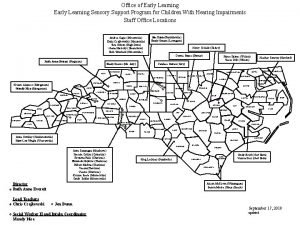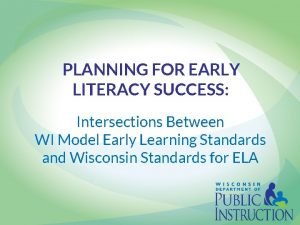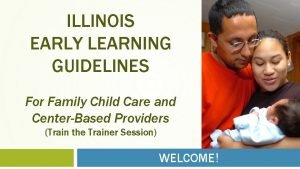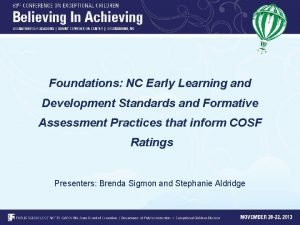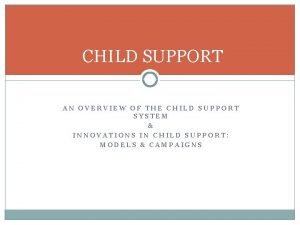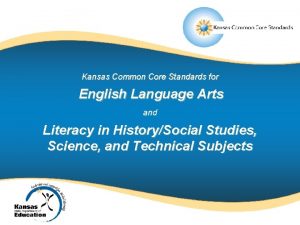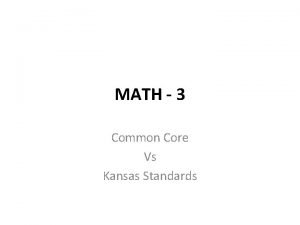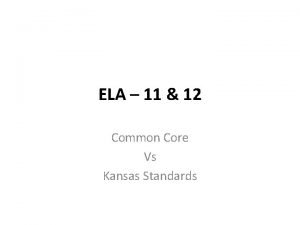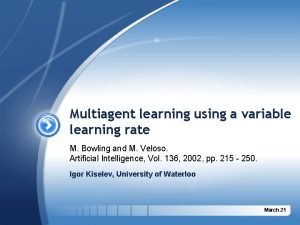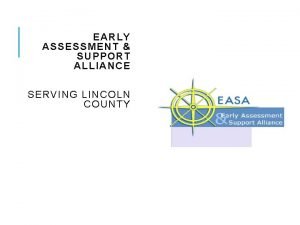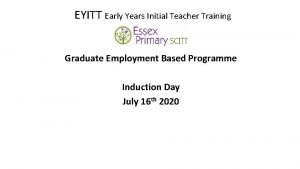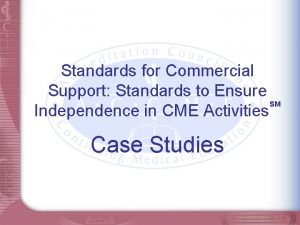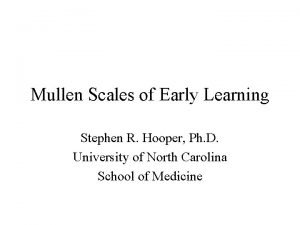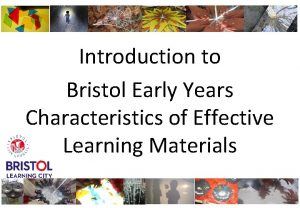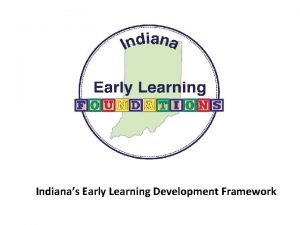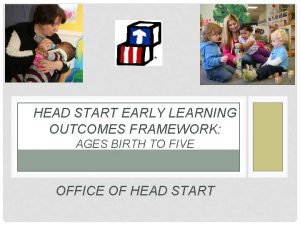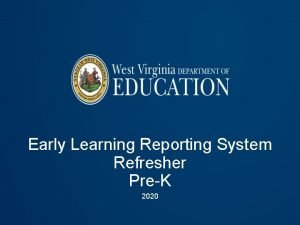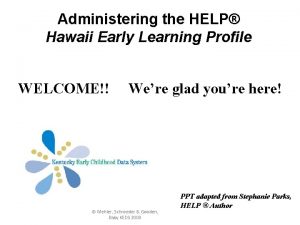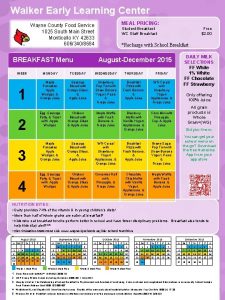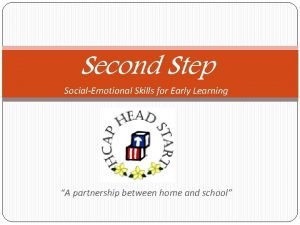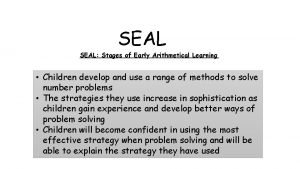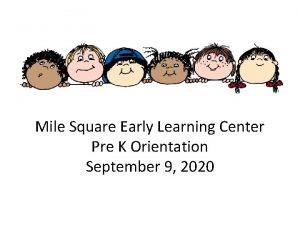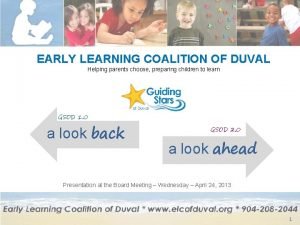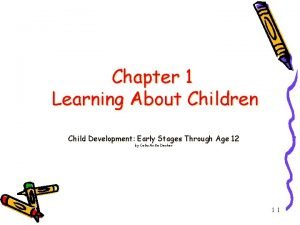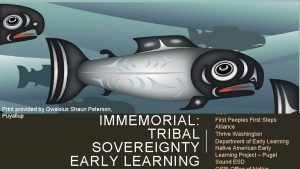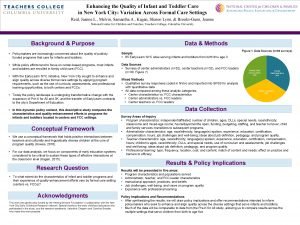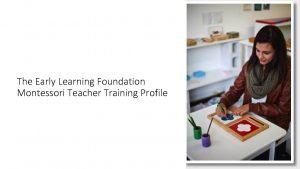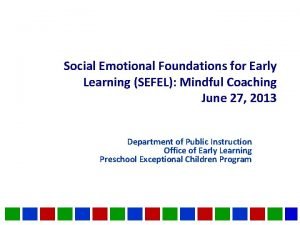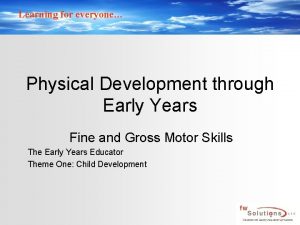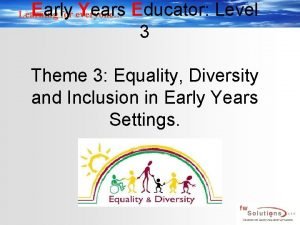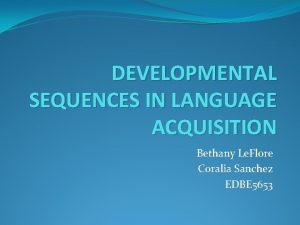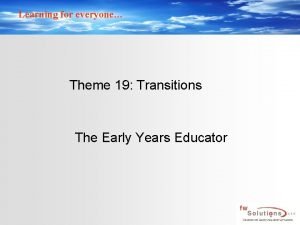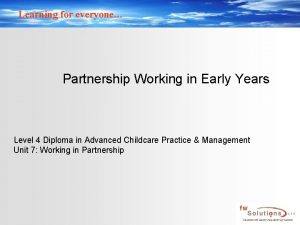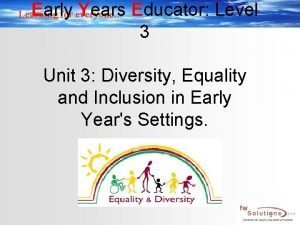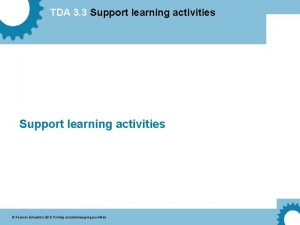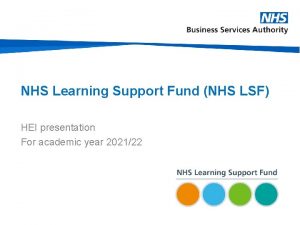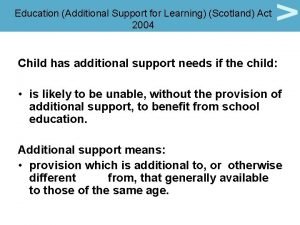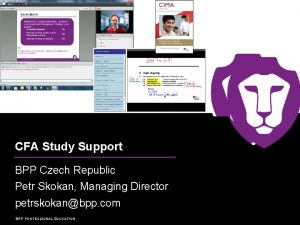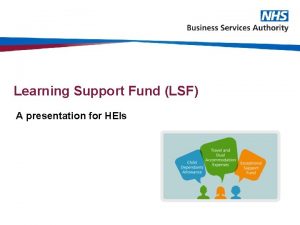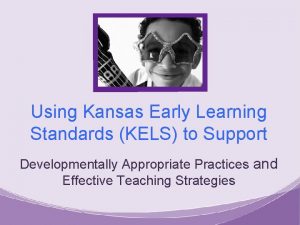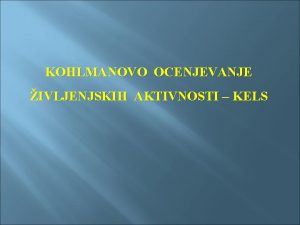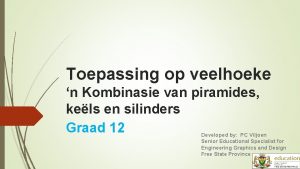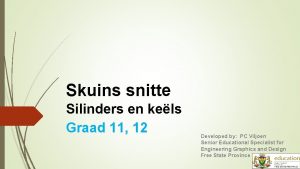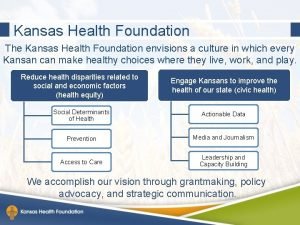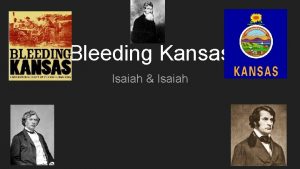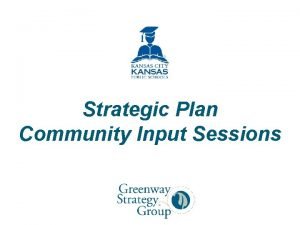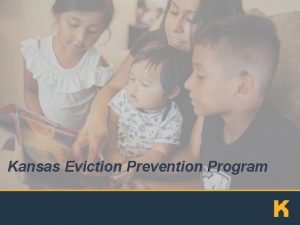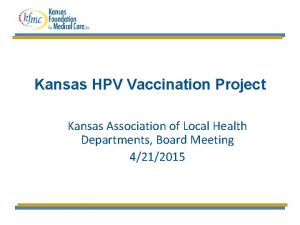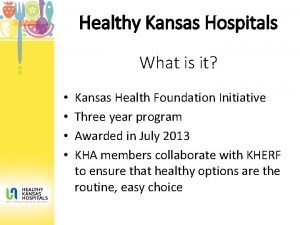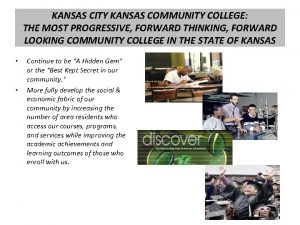Using Kansas Early Learning Standards KELS to Support
















































- Slides: 48

Using Kansas Early Learning Standards (KELS) to Support Dual Language Learners (DLLs)

KELS Toolkits • This is one in a series of toolkit presentations developed to guide early care and education providers in appropriate and effective use of the Kansas Early Learning Standards (KELS). • As a pre-requisite to this training, participants should first be familiar with the KELS Overview Toolkit and the KELS document.

How do Kansas Early Learning Standards (KELS) Support DLLs? Making the connections: • Conceptual knowledge and skills • Guiding principles from School Readiness Framework • Kansas College and Career Ready Standards (KCCRS) Kansas Early Learning Standards (2014 Revision) http: //www. ksde. org/Portals/0/Early %20 Childhood/Early%20 Learning% 20 Standards/Ks. Early. Learning. Stand ards. pdf

Learner Objectives • Understand how the KELS can be used to support young DLLs (birth to five) and their families. • Identify universal research-based recommendations/strategies for supporting effective early learning opportunities for young DLLs across settings (home, childcare, preschool, community). • Identify and access professional development resources aligned with KELS to guide you in providing effective supports for DLLs and their families.

Who are Dual Language Learners (DLLs)? “Dual language learners are young children who are learning two or more languages at the same time or are learning a second language while continuing to develop their first or home language. ” (KELS, 2014, p. 28)

Conceptual Knowledge and Skills Whole child • Birth to five • Sequential development across domains Higher level thinking strategies • Analyzing • Evaluating • Interpreting

Analyzing

Evaluating

Interpreting

Guiding Principles (from Kansas School Readiness Framework, 2012) • From birth, children are ready to learn. Parents, families and caregivers are children’s first teachers • Learning is a lifelong activity and every environment is a learning environment • Children’s success in school and in life is everyone’s responsibility. Communities, educational environments, families and children are ready to support success

Guiding Principles (from Kansas School Readiness Framework, 2012) (continued) • School readiness involves the whole child in the context of the family and the community. This includes the child’s health and development in the following areas: physical, social, emotional, cognitive and general knowledge, communication and literacy • Integrated services are available to children, appropriate to the age, abilities, language and culture of each child • Schools are ready to support the success of each child, recognizing their wide range of cultural and linguistic backgrounds, learning experiences and differences in abilities • A strong, direct connection exists in the early years between the quality of children’s health and experiences and their later success in school and in life. School readiness in Kansas depends on involvement from public policy, funding and system supports

Kansas College and Career Ready Standards (KCCRS) KELS 2014 aligns with • Kindergarten to Grade 3 Standards for • Reading (Communication and Literacy) • Mathematics • Social, Emotional, and Character Development

How are Needs of ALL Children Addressed in the Revised KELS? The 2014 KELS revision • Is based on current research and evidence based practices • Reflects a wide range of developmentally appropriate abilities and expectations • Provides common language for families and professionals to identify individual child’s strengths and needs • Sets stage for developing or selecting appropriate curriculum • Provides valuable information on critical knowledge and skills and major concepts to be assessed

Research-Based Recommendations Specific to Needs of Young DLLs • Supporting all children - from the earliest ages - in learning their home language as well as English and becoming bilingual • Engaging families in partnerships based on mutual respect and ongoing two-way communication regarding important cultural beliefs, family experiences, and expectations for their children's learning • Reviewing early learning standards for appropriate expectations for dual language learners • Using instructional strategies to teach essential academic concepts in the child's home language, within familiar cultural contexts

Research-Based Recommendations Specific to Needs of Young DLLs (continued) • Assessing knowledge and abilities of dual language learners across domains in both languages • Providing culturally and linguistically appropriate professional development for all early care and education staff (Espinosa, 2013)

How is Research on DLLs Addressed in Revised KELS? “…we do not find evidence to support a separate set of ‘second language’ learning experiences. Instead, our view of the research indicates that language development — be it first or second — is supported through social interactions that are supportive, culturally and individually relevant, and cognitively challenging. ” (Stechuk, Burns, & Yandian, 2006, p. 46)

How is Research on DLLs Addressed in Revised KELS? Communication and Literacy Skill Development “Research shows that overwhelming young children with a new language at the expense of the home language does not help them learn the new language faster and may, in fact, hinder cognitive development. Therefore, early childhood programs that include dual language learners should build learning programs that strongly support continued development in the home language while also scaffolding English skill development. ” (KELS, 2014, p. 28)

How is Research on DLLs Addressed in Revised KELS? Social-Emotional Development • “Parents, teachers, and all caregivers should help young children gain confidence and competence in living and learning with others and functioning independently and cooperatively by providing positive early experiences, especially positive interactions. ” • “Social skills, self-regulation, friendship skills and social problem-solving should continue to be taught along side academic skills in early childhood classrooms since they are likewise critical for school success. ” (KELS, 2014, p. 19)

How is Research on DLLs Addressed in Revised KELS? Approaches to Learning • How children use their capacities to acquire knowledge and skills can be a reflection of “gender, temperament or cultural patterns and values. ” • “Adults need to first understand the various ways children become involved in learning in order to know how to encourage and enhance their engagement during learning opportunities. ” (KELS, 2014, p. 9)

What is Universal Design for Learning (UDL)? “Getting it right from the start so that every child: • feels welcomed as a full and equal member • accesses and engages in all learning opportunities • learns according to his or her individual strengths and interests • demonstrates his or her learning in ways that reflect the individual’s strengths” (Conn-Powers, 2006, p. 1)

Supporting DLLs Through Universal Design for Learning (UDL) UDL is a framework for providing all children equal opportunity for learning (www. cast. org). Principles include providing multiple and flexible means of: • Representation (to allow for diverse learning styles in how children access information and acquire knowledge) • Action and expression (to allow diverse options for children to demonstrate what they have learned) • Engagement (to use children’s own interests to challenge and motivate them to learn)

UDL: Checking for Understanding Indicate the number of the UDL principle illustrated by each of the following examples of instructional strategies linked with KELS/CCL/Literature/Key Ideas and Details (p. 30). 1) Representation 2) Action/Expression 3) Engagement • • • Children respond to open questions of varying complexity about the story verbally with words, by pointing to or naming pictures, with sign language, or using assistive communication device Picture books are provided in variety of sizes, textures, colors, patterns, flaps, with sounds, or paired with high interest toys High interest story books and non-fiction books of varying complexity and languages are available in multiple formats and locations, embedded in activities and routines throughout the day

What Does Research Suggest About Assessment of DLLs? “The early childhood profession and bilingual assessment experts have not yet agreed on a specific set of tools and procedures to accurately appraise the developmental status of the vast range of young children who are learning more than one language during the preschool years. ” (Espinosa & Lopez, 2007 in Schilder, 2013, p. 2)

Key Recommendations on Assessing DLLs “Information gathered from any assessment process (regardless of whether constructed in one or more languages) will be most effective when combined with information gathered from teachers, families, and careful observation when making any decisions about the educational functioning of young ELLs. ” (Espinosa & Lopez, 2007, in Schilder, 2013, p. 2)

What Kind of Assessment Information Should be Gathered from Families, Teachers, and Others? (National Center on Cultural and Linguistic Responsiveness, HHS/ACF/OHS, 2013)


What Does Support Look Like for Infants and Toddlers? In the home, parents and other adults provide frequent and repetitive language experiences by • Talking with children in their home language(s) • Reading books or telling stories to children in their home language(s) • Encouraging children to use their home language in conversations with family and friends (Prieto, 2009)

What Does Support Look Like for Infants and Toddlers? In family or group care settings, adults intentionally and continuously support dual language learning of infants and toddlers by: • Having conversations with them during daily routines (diapering, meal time, preparing for nap) • Reading with them, incorporating common words, or familiar stories and songs in the child’s home language • Verbally labeling toys, objects, food, and other items of interest to the child • Invite family and community members from the child’s community to share cultural experiences (songs, stories, food) (Prieto, 2009)

What Does Support Look Like for Infants and Toddlers? In family or group care settings, adults intentionally and continuously support dual language learning of infants and toddlers by • Learning about and sharing the benefits (cognitive, social, economic) of bilingualism with families • Respecting family values and beliefs, including being responsive to their preference for their infant or toddler’s language use • Using interpreters, when necessary and possible, to communicate with family members in their own language • Making families welcome by creating activities they can engage in with their child in your setting and at home (Prieto, 2009)

What Does Support Look Like in Early Care and Education? • Authentic pictures, posters, and items from children’s cultures and languages in books, games, centers • Labels in home languages of all children • New vocabulary introduced to all children with props, visual supports, contextual cues • Embedded opportunities for some children to practice vocabulary in additional activities and routines • Learning centers/curriculum activities extended for days at a time allowing for practice and building on prior knowledge • A “survival chart” posted with pictures/text of basic needs (food, drink, bathroom, etc. ) (Nemeth, 2009)

What Does Support Look Like in Early Care and Education? • Bilingual adults (staff, family members and/or visitors) read, talk, and play with children in their home languages • Children talk with adults and peers in their home languages • Music representing every child’s culture is played, sung, and/or available at centers • Teachers collaborate with parents to teach familiar songs in more than one language • Children may volunteer to translate for adults or peers • At times, instruction occurs in child’s home language during small group activities (Nemeth, 2009)

What Does Support Taste Like in Early Care and Education? • Adults encourage conversations in multiple languages at meal time, seating children next to peers with same home languages • Snacks, drinks, meals, and parties include food from different cultures side-by-side • Recipes from children’s families are used for learning math and science (Nemeth, 2009)

What Does Support Feel Like in Early Care and Education? • Children feel welcomed, supported and encouraged because teachers learned a few ‘survival words’ in each language before school started • The classroom feels safe because teachers do not allow any teasing, bullying, or isolation and they help all of the children learn to communicate and play together • Families feel welcome and respected because plenty of information is available to them in their home language (Nemeth, 2009, p. 42)

What Have We Learned Today about Supporting DLLs in Our Settings? Reflection Activity • Select at least one of the three scenarios on your handout • With a partner or in a small group, reflect on steps you would take to support the child(ren) and adults in the situation described, using • Information from the KELS such as • Guiding Principles. • Sequential developmental content by domains • Best practice recommendations for supporting DLLs and their families • Your professional wisdom, judgment, and experience

Read and Reflect Taking the perspective of the early care or education provider… • What is the dilemma or main problem that you see • Based on what you have heard today, how might you respond • What questions arise from this scenario? What would you like to know more about • How might the KELS be helpful (to you or the family) in this situation


Christopher Hu is a healthy, well-behaved 4 -year-old who lives with his parents and grandparents in an urban community. His parents are both physicians and Christopher has been cared for primarily by his Mandarin speaking grandparents since birth. Christopher's parents believe he would benefit from participating in a community preschool with predominantly English-speaking children next year in preparation for kindergarten. Christopher's grandparents are concerned that if Christopher goes to preschool, he will not understand the other children or the teacher's expectations and they will not be able to communicate with his teacher. They want Christopher's parents to wait on sending him to preschool.

Valeria is nearly fifteen months old. She and her nineteen year-old mother Sofia, have participated in the Parents as Teachers program for the past six months. Sofia and her family communicate primarily in Spanish, although Sofia is also a fluent English speaker. As Valeria has begun using a few words, Sofia's parents and grandmother have advised her to speak to Valeria only in English so she will be prepared for success in kindergarten.

Naveed Ms. Amanda has just learned that the new student starting in her preschool class next week is from Pakistan and although his father speaks English, his mother and siblings only speak Urdu for the most part. Ms. Amanda's curriculum is centered on developmentally appropriate practice and aligned with the Kansas Early Learning Standards. She wants to know how to prepare her classroom, and her students, to make Naveed and his family feel welcome.

Optional Take-Home Activities Additional Scenarios As an extension of your own learning or to reflect on shared practices with others in your workplace setting, download • Strategies for Supporting All Dual Language Learners http: //eclkc. ohs. acf. hhs. gov/hslc/ttasystem/cultural-linguistic/fcp/docs/dllstrategies. pdf

For More Information KELS Virtual Toolkit: on Dual Language Learners (available on KELS Flash Drive) • QT • I need a better understanding of this topic. Where should I begin • How do I find out what works to support infants and young children in this area • Show me what implementation looks like (for adults and children) in classroom and nonclassroom settings • How can I get additional training on this topic • I would like to share this information with others, in a group setting. Is there a trainer's version of this virtual toolkit • Evaluation

Evaluation • What is one big idea or take home message from what you heard today • What excites you or concerns you about what you learned • Any insights from the session • How will you use what you learned from this session

References Conn-Powers, M. , Conn-Powers, A. F. , Traub. , E. K. , & Hunter-Pishgahi, L. (2006, September). The universal design of early education: Moving forward for all children. Beyond the Journal: Young Children on the Web. http: //www. iidc. indiana. edu/styles/iidc/defiles/ECC_Universal_De sign_Early_Education. pdf Espinosa, L. M. (2013). Pre. K-3 rd: Challenging common myths about dual language learners. New York, NY: Foundation for Child Development. http: //fcdus. org/sites/default/files/Challenging%20 Common%20 Myths %20 Update. pdf Kansas Early Learning Standards Committee (2014). Kansas Early Learning Standards: Building the Foundations for Successful Children. Topeka, KS: Kansas State Department of Education. http: //www. ksde. org/Portals/0/Early%20 Childhood/Early%20 Learning %20 Standards/Ks. Early. Learning. Standards. pdf

References National Center on Cultural and Linguistic Responsiveness (2013). Gathering and Using Language Information Families Share. HHS/ ACF/OHS. http: //eclkc. ohs. acf. hhs. gov/hslc/tta-system/culturallinguistic/fcp/docs/dll_background_info. pdf National Center on Cultural and Linguistic Responsiveness (n. d. ). Strategies for Supporting All Dual Language Learners. HHS/ACF/OHS. http: //eclkc. ohs. acf. hhs. gov/hslc/tta-system/culturallinguistic/fcp/docs/dll-strategies. pdf Nemeth, K. (2009). Meeting the home language mandate: Supporting all kinds of learners. NAEYC: Young Children, March, 36 -42. http: //eclkc. ohs. acf. hhs. gov/hslc/ttasystem/teaching/eecd/Domains%20 of%20 Child%20 Development/L anguage%20 Development%20 and%20 Communication/meetingtheh omelangage. pdf

References Prieto, H. V. (2009). One language, two languages, three languages… more? Supporting infants, toddlers, and their families. Young Children, January 2009. NAEYC. http: //www. naeyc. org/files/yc/file/200901/BTJRacing. Rolling. pdf Schilder, D. (2013). Training to screen young English language learners and dual language learners for disabilities. CEELO FAST facts, New Brunswick, NJ: Center on Enhancing Early Learning Outcomes (3 -5 Years). http: //ceelo. org/wp-content/uploads/2013/08/Training-to-Screen. Young-ELLs-and-DLLs-for-Disabilities. pdf Stechuk, Robert, Burns, Susan and Yanadian, Sharon (2006). Bilingual Infant/Toddler Environments: Supporting Language and Learning in Our Youngest Children. A Migrant and Seasonal Head Start Technical Assistance Center AED. http: //eclkc. ohs. acf. hhs. gov/ods/resource/detail/bilingual-infanttoddlerenvironments-supporting-language-and-learning-in-our-youngestchildren/

Acknowledgement The Kansas Early Learning Standards (KELS) Training Project, a project of the University of Kansas, Life Span Institute at Parsons, was funded through a grant from the Kansas State Department of Education with funds from the Kansas Children’s Cabinet and Trust Fund. Leadership support for this project was provided by the Kansas State Agencies Early Childhood Leadership Team with representatives from: • Kansas Children’s Cabinet and Trust Fund • Kansas Department for Children and Families • Kansas Department of Health and Environment • Kansas State Department of Education

Contacts Kansas Children’s Cabinet and Trust Fund Landon State Office Building 900 SW Jackson St. , Rm. 152 Topeka, Kansas 66612 785. 368. 7044 or 877. 204. 5171 Kansas Department for Children and Families Child Care and Early Education 555 S. Kansas Avenue Topeka, Kansas 66032 785. 296. 3271 or 800. 332. 6262 Kansas Department of Health and Environment Children and Families Services Curtis State Office Building 1000 SW Jackson St. Topeka, Kansas 66612 785. 296. 1500 or 800. 332. 6262 Kansas State Department of Education Early Childhood, Special Education, and Title Services Landon State Office Building 900 SW Jackson St. Topeka, Kansas 66612 785. 296. 7454 or 800. 203 -9462

Acknowledgement Suggested reference for this Power. Point: Rinkel, P. , Heintz, C. , Mitchell, L. , & Lindeman, D. P. (2016). Using Kansas Early Learning Standards (KELS) to Support: Dual language learners (DLLs). Life Span Institute at Parsons, University of Kansas, Parsons, KS.
 Kansas kansas state fight
Kansas kansas state fight Early learning sensory support program
Early learning sensory support program Wisconsin model early learning standards
Wisconsin model early learning standards Illinois early learning guidelines
Illinois early learning guidelines Nc early learning standards
Nc early learning standards Child support arrears forgiveness letter missouri
Child support arrears forgiveness letter missouri Kansas ela standards
Kansas ela standards Math standards kansas
Math standards kansas Kansas ela standards
Kansas ela standards Multiagent learning using a variable learning rate
Multiagent learning using a variable learning rate Early cpr and early defibrillation can: *
Early cpr and early defibrillation can: * Cuadro comparativo e-learning b-learning m-learning
Cuadro comparativo e-learning b-learning m-learning Early assessment and support alliance
Early assessment and support alliance Early years teacher standards
Early years teacher standards Main idea major and minor details
Main idea major and minor details Standards for commercial support
Standards for commercial support Factors determining service standards
Factors determining service standards Hgioelc
Hgioelc Oregon early learning and kindergarten guidelines
Oregon early learning and kindergarten guidelines Seal numeracy
Seal numeracy Mullen scales of early learning
Mullen scales of early learning Bristol characteristics of effective learning
Bristol characteristics of effective learning Indiana early learning foundations
Indiana early learning foundations Head start early learning outcomes framework
Head start early learning outcomes framework Eylf meaning
Eylf meaning Elrs reporting system
Elrs reporting system Hawaii early learning profile
Hawaii early learning profile Walker early learning center
Walker early learning center Second step social emotional skills for early learning
Second step social emotional skills for early learning Stages of early arithmetical learning
Stages of early arithmetical learning Square one early learning center
Square one early learning center Early learning coalition of duval
Early learning coalition of duval Chapter 1 early learning
Chapter 1 early learning Storybook
Storybook Adelphi early learning center
Adelphi early learning center Mtt teacher training
Mtt teacher training Sefel training
Sefel training Early learning for everyone
Early learning for everyone Early learning for everyone
Early learning for everyone Developmental sequence in language acquisition
Developmental sequence in language acquisition Early learning for everyone
Early learning for everyone Early learning for everyone
Early learning for everyone Early learning for everyone
Early learning for everyone Early childhood is ____ for language learning
Early childhood is ____ for language learning Tda 3.3 support learning activities
Tda 3.3 support learning activities Lsf nhs
Lsf nhs Additional support for learning act 2004
Additional support for learning act 2004 Study.bpp.com
Study.bpp.com Lsfas
Lsfas

